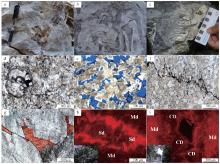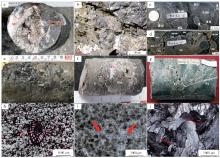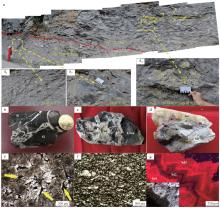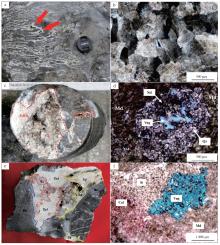

石油与天然气地质 ›› 2021, Vol. 42 ›› Issue (6): 1265-1280.doi: 10.11743/ogg20210603
李双建1,2( ), 杨天博3, 韩月卿1,2, 高平3, 沃玉进1, 何治亮2,4
), 杨天博3, 韩月卿1,2, 高平3, 沃玉进1, 何治亮2,4
收稿日期:2020-07-28
出版日期:2021-12-28
发布日期:2021-12-16
第一作者简介:李双建(1978-), 男, 研究员, 构造地质与盆地分析。E-mail: 基金项目:
Shuangjian Li1,2( ), Tianbo Yang3, Yueqing Han1,2, Ping Gao3, Yujin Wo1, Zhiliang He2,4
), Tianbo Yang3, Yueqing Han1,2, Ping Gao3, Yujin Wo1, Zhiliang He2,4
Received:2020-07-28
Online:2021-12-28
Published:2021-12-16
摘要:
四川盆地中二叠统热液白云岩类型多、分布广,对油气勘探具有重要意义,但是关于热液白云岩化作用的机理和模式及其对储层的改造意义存在较多争议。在系统收集前期研究资料的基础上,通过对典型地区热液白云岩的矿物学、岩相学和地球化学等详细分析,总结了热液白云岩化作用的机理及其储层改造意义。研究认为:四川盆地中二叠统热液白云岩化作用与围岩的岩性和岩相没有明显的相关性,主要与同期断裂活动有关。根据热液白云岩与围岩的关系,可以将热液白云岩化模式分为3类:①滩相改造型热液白云岩化,主要分布在川西和川中地区的栖霞组中,热液白云岩化作用对储层的建设性改造作用不明显;②岩溶灰岩改造型热液白云岩化,主要分布在川中地区的茅口组中,热液白云岩化作用对该类储层的建设性改造作用也不明显;③致密灰岩改造型热液白云岩化,主要发育在川东地区的茅口组中,热液白云岩化作用对该类储层的建设性改造作用比较明显。断裂裂缝、充填残余的溶蚀孔和白云石晶间孔是热液改造型储层的主要储集空间,相比于原岩物性较好的储层,原始储集物性较差的储层受热液及其相关构造作用改造后,物性改善更加明显。
中图分类号:
表1
四川盆地中二叠统白云岩厚度统计"
| 剖面或钻井 | 白云岩厚度/m | 成因 | 资料来源 | 剖面或钻井 | 白云岩厚度/m | 成因 | 资料来源 | |
| 女基 | 25.0 | 热液 | 陈轩等,2012[ | 卧67 | 23.0 | - | 韩晓涛等,2016[ | |
| 汉深1 | 62.0 | 热液 | 陈轩等,2013[ | 广探2 | 31.0 | 热液 | 刘宏等,2016[ | |
| 大邑大飞水 | 5.0 | 热液 | 张文等,2014[ | 周公1 | 50.5 | 热液 | 胡安平等,2018[ | |
| 宝兴西大河 | 70.0 | 热液 | 张文等,2014[ | 江油五花洞 | 23.0 | - | 胡安平等,2018[ | |
| 华蓥山二崖 | 28.0 | - | 张文等,2014[ | 广参2 | 25.0 | 热液 | 胡安平等,2018[ | |
| 华蓥山西天 | 10.0 | - | 张文等,2014[ | 双探3 | 23.0 | - | 胡安平等,2018[ | |
| 新开寺 | 37.0 | 热液 | 张文等,2014[ | 大深1 | 96.4 | 热液 | 胡安平等,2018[ | |
| 汉6 | 78.0 | - | 张文等,2014[ | 汉1 | 112.0 | 热液 | 胡安平等,2018[ | |
| 油1 | 4.0 | - | 张文等,2014[ | 磨溪39 | 20.0 | - | 胡安平等,2018[ | |
| 华蓥山地质公园 | 15.0 | - | 张文等,2014[ | 南充1 | 16.0 | - | 胡安平等,2018[ | |
| 张村 | 84.0 | 热液 | 张文等,2014[ | 七里23 | 18.4 | - | 张坤贞等,2019[ | |
| 广元杨家崖 | 31.0 | - | 张文等,2014[ | 雷西1 | 4.8 | - | 张坤贞等,2019[ | |
| 广元长江沟 | 34.0 | 热液 | 张文等,2014[ | 川付85 | 10.6 | - | 张坤贞等,2019[ | |
| 广元上寺 | 30.0 | - | 张文等,2014[ | 川岳84 | 22.0 | - | 张坤贞等,2019[ | |
| 广元车家坝 | 5.0 | 热液 | 张文等,2014[ | 普光5 | 11.6 | - | 张坤贞等,2019[ | |
| 广元西北乡 | 42.0 | 热液 | 张文等,2014[ | 毛坝3 | 5.0 | - | 张坤贞等,2019[ | |
| 河6 | 5.0 | - | 张文等,2014[ | 明1 | 26.0 | - | 张坤贞等,2019[ | |
| 卧115 | 26.0 | 热液 | 张文等,2014[ | 雷北1 | 11.5 | - | 张坤贞等,2019[ | |
| 卧85 | 10.5 | 热液 | 张文等,2014[ | 清溪3 | 16.8 | - | 张坤贞等,2019[ | |
| 通口 | 27.5 | - | 张文等,2014[ | 泰来6 | 23.0 | 热液 | 胡东风等,2019[ | |
| 天井山阴泉山 | 5.0 | - | 张文等,2014[ | 宝兴五龙 | 34.5 | 热液 | 本项目实测 | |
| 松盖坪 | 9.0 | - | 张文等,2014[ | 旺苍正源 | 4.0 | - | 本项目实测 | |
| 绵竹高桥 | 15.5 | - | 张文等,2014[ | 丰都放牛坝 | 25.0 | 热液 | 本项目实测 | |
| 旺苍王家沟 | 1.7 | - | 张文等,2014[ | 阆中1 | 25.0 | - | 井资料 | |
| 吴家1 | 31.0 | 热液 | 张文等,2014[ | 川深1 | 15.0 | 热液 | 井资料 | |
| 矿2 | 44.0 | 热液 | 张文等,2014[ | 永兴1 | 15.0 | 热液 | 井资料 | |
| 双探1 | 22.0 | - | 宋晓波等,2016[ | 关基 | 8.0 | - | 井资料 |

图2
川西地区中二叠统栖二段颗粒滩相白云岩及相关热液白云岩岩石学特征 a.浅灰色块状白云岩,发育不规则溶蚀孔洞(红色箭头所指),内部有方解石、沥青充填,广元长江沟剖面;b.灰色斑状白云岩,基质灰岩为浅灰色,云斑为深灰色呈不规则拉长状,广元长江沟剖面;c.浅灰色基质白云岩中的斑马纹构造,宝兴五龙剖面;d.具有腹足类生屑幻影的白云岩,单偏光,ST3井,埋深7 430.9 m;e.平直晶面自形中晶白云岩,雾心亮边结构明显,孔隙中常见沥青充填,单偏光,蓝色铸体,ST3井,埋深7 458.6 m;f.非平直晶面他形细晶白云岩,伴有缝合线发育,单偏光,蓝色铸体,ST3井,埋深7 460.1 m;g.裂缝中充填的鞍状白云石胶结物,晶面弯曲呈镰刀状,单偏光,茜素红染色,ST3井,埋深7 441.0 m;h.溶洞内充填的鞍形白云石胶结物(Sd),周围基质白云岩(Md)也有遭受热液改造重结晶的特征,单偏光,宝兴五龙剖面;i.溶洞中充填的平直自形-半自形中-粗晶白云石胶结物(CD),晶粒直径明显大于基质白云岩(Md),单偏光,ST3井,埋深7 449.1 m"


图5
川中地区中二叠统岩溶灰岩及相关热液白云岩岩石学特征 a.深灰色白云岩间发育的溶洞(红色虚线内),内部见乳白色鞍形白云石(Sd)-方解石(CC)半充填,埋深4 705.27 m,广探2井,茅二段,据汪华等[11];b.角砾灰岩(LB)与角砾间的云质充填(D),见方解石充填(CC)的溶洞发育,邻水黄孔槽剖面,茅口组,据刘宏等[33];c.溶洞(DC)中的灰质角砾(LB)和云质充填(D),埋深4 606.98 m,广参2井,茅三段,据刘宏等[33];d.溶洞(DC)中的云质角砾(DB)和硅质白云岩(SiD)充填,大量溶孔溶洞发育,埋深4 605.62 m,广参2井,茅三段,据刘宏等[33];e.角砾白云岩(BD),角砾间为硅质岩和生屑灰岩,不规则水力破裂缝(Fx)发育,埋深4 591.50 m,广参2井,茅三段,据陈轩等[13];f.深灰色细中晶白云岩内发育水力破裂缝(Fx)和爆裂角砾(Bre),鞍形白云石充填,埋深4 591.20 m,广参2井,茅三段,据汪华等[11];g.白云岩角砾和伴生的不规则水力破裂缝(Fx),溶孔溶洞发育,二崖剖面,茅口组,据汪华等[11];h.残余灰质细-中晶白云岩,内部见灰质蜓类生屑,茜素红染色,单偏光,二崖剖面,据刘建强等[16];i.细-中晶基质白云岩,白云石晶粒具有雾心亮边结构,发育部分晶间孔(红色箭头),单偏光,二崖剖面,据刘建强等[16];j.溶洞内充填的粗-巨晶鞍形白云石,波状消光特征明显(红色箭头),广参2井,埋深4 612.00 m,茅三段,据陈轩等[14]"


图7
川东地区中二叠统致密灰岩及相关热液白云岩岩石学特征 a.白云岩层系和基质灰岩的产状关系,接触界面不平整,围岩主要是相对深水沉积的眼球状灰岩(a1)、硅质灰泥灰岩(a2)等,白云岩层段内部多溶孔、溶洞发育(a3),茅三段,丰都狗子水剖面;b.硅质白云岩内发育的水力破裂缝(Fx),缝内有鞍形白云石(Sd)充填,埋深5 510.6 m,茅三段,泰来6井;c.基质灰岩中发育的水力破裂缝(Fx),粗晶-巨晶鞍形白云石(Sd)充填,茅三段,丰都狗子水剖面;d.沿基质白云岩(Md)边缘溶洞壁生长的石英晶体(Qz)和方解石胶结物(Cal),石英呈柱状、晶型完好,茅三段,丰都狗子水剖面;e.中-细晶基质白云岩,平直半自形-非平直他形晶,晶间有沥青充填(黄色箭头),单偏光,茅三段,丰都狗子水剖面;f.细粉晶白云岩,晶间泥质含量较多,仍能观察到一定的定向性,单偏光,茅三段,丰都狗子水剖面;g.粗晶鞍形白云石胶结物的阴极发光图像,可见多期次生长环带(Sd1-Sd2-Sd3),晶面呈弯曲状,左下小图为对应的单偏光照片,埋深5 530.4 m,茅三段,泰来601井"


图9
四川盆地中二叠统热液白云岩化对储层的改造特征 a.厚层-块状基质白云岩,斑马纹发育,其内部大部分被鞍形白云石充填,孔洞发育程度较差,仅有少量残余孔洞,栖二段,宝兴五龙剖面;b.热液改造重结晶的基质白云岩,白云石晶体具有弱波状消光特征,仅有少量晶间孔发育,正交偏光,埋深7 442.5 m,栖二段,双探3井;c.基质白云岩中溶洞发育,内部见自形晶鞍状白云石(Sd)-方解石(CC)半充填,埋深4 705.3 m,茅二段,广参2井;d.基质白云岩(Md)内发育的溶洞,内部充填的鞍形白云石(Sd)和石英晶体(Qz),单偏光,蓝色铸体,茅二段,黄孔槽剖面(据刘宏等[8]);e.基质白云岩(Md)溶洞中发育的鞍形白云石(Sd)、方解石(Cal)、石英晶体(Qz)和晶间溶孔(Vug),茅三段,丰都狗子水剖面;f.硅质白云岩中发育的晶间溶孔,单偏光,蓝色铸体,茅三段,丰都狗子水剖面(据胡东风等[18])"

| 1 |
Machel H G , Lonnee J . Hydrothermal dolomite-A product of poor definition and imagination[J]. Sedimentary Geology, 2002, 152 (3-4): 163- 171.
doi: 10.1016/S0037-0738(02)00259-2 |
| 2 |
Davies G R , Smith Jr L B . Structurally controlled hydrothermal dolomite reservoir facies: An overview[J]. AAPG Bulletin, 2006, 90 (11): 1641- 1690.
doi: 10.1306/05220605164 |
| 3 | 张涛, 林娟华, 韩月卿, 等. 四川盆地东部中二叠统茅口组热液白云岩发育模式及对储层的改造[J]. 石油与天然气地质, 2020, 41 (1): 132- 143. |
| Zhang Tao , Lin Juanhua , Han Yueqing , et al. Pattern of hydrothermal dolomitization in the Middle Permian Maokou Formation, eastern Sichuan Basin, and its alteration on reservoirs herein[J]. Oil & Gas Geology, 2020, 41 (1): 132- 143. | |
| 4 | 陈代钊, 张艳秋, 周锡强, 等. 塔里木盆地西缘上寒武统下丘里塔格群热液白云岩改造时限: 来自古地磁的约束[J]. 石油与天然气地质, 2020, 41 (1): 50- 58. |
| Chen Daizhao , Zhang Yanqiu , Zhou Xiqiang , et al. Timing of hydrothermal alteration on the Lower Qiulitag Group dolomites of the Upper Cambrian, western margin of Tarim Basin: Palaeomagnetic constraint[J]. Oil & Gas Geology, 2020, 41 (1): 50- 58. | |
| 5 | 唐雪松, 谭秀成, 刘宏, 等. 四川盆地东部中二叠统茅口组白云岩及云质硅岩储层特征与发育规律[J]. 石油与天然气地质, 2016, 37 (5): 731- 743. |
| Tang Xuesong , Tan Xiucheng , Liu Hong , et al. Characteristics and development mechanism of dolomite and dolomitic quartzite reservoirs of the Middle Permian Maokou Formation in eastern Sichuan Basin[J]. Oil&Gas Geology, 2016, 37 (5): 731- 743. | |
| 6 | 孙福宁, 胡文瑄, 胡忠亚, 等. 断裂-层序双控机制下的热液活动及成储效应——以塔里木盆地塔河、玉北地区下奥陶统为例[J]. 石油与天然气地质, 2020, 41 (3): 558- 575. |
| Sun Funing , Hu Wenxuan , Hu Zhongya , et al. Impact of hydrothermal activities on reservoir formation controlled by both faults and sequences boundaries: A case study from the Lower Ordovician in Tahe and Yubei areas, Tarim Basin[J]. Oil & Gas Geology, 2020, 41 (3): 558- 575. | |
| 7 | 焦存礼, 何治亮, 邢秀娟, 等. 塔里木盆地构造热液白云岩及其储层意义[J]. 岩石学报, 2011, 27 (1): 277- 284. |
| Jiao Cunli , He Zhiliang , Xing Xiujuan , et al. Tectonic hydrothermal dolomite and its significance of reservoirs in Tarim Basin[J]. Acta Petrologica Sinica, 2011, 27 (1): 277- 284. | |
| 8 |
宋光永, 刘树根, 黄文明, 等. 川东南丁山-林滩场构造灯影组热液白云岩特征[J]. 成都理工大学学报(自然科学版), 2009, 36 (6): 706- 715.
doi: 10.3969/j.issn.1671-9727.2009.06.016 |
|
Song Guangyong , Liu Shugen , Huang Wenming , et al. Characteristics of hydrothermal dolomite of Upper Sinian Dengying Formation in the Dingshan-Lintanchang structural zone, Sichuan Basin, China[J]. Journal Of Chengdu University Of Technology (Science & Technology Edition), 2009, 36 (6): 706- 715.
doi: 10.3969/j.issn.1671-9727.2009.06.016 |
|
| 9 | 何治亮, 马永生, 张军涛, 等. 中国的白云岩与白云岩储层: 分布、成因与控制因素[J]. 石油与天然气地质, 2020, 41 (1): 1- 14. |
| He Zhiliang , Ma Yongsheng , Zhang Juntao , et al. Distribution, genetic mechanism and control factors of dolomite and dolomite reservoirs in China[J]. Oil & Gas Geology, 2020, 41 (1): 1- 14. | |
| 10 |
李毅, 沈浩, 石学文, 等. 川东-川中地区茅口组白云岩成因初探及"热次盆" 概念的提出[J]. 天然气勘探与开发, 2013, 36 (4): 1- 3.
doi: 10.3969/j.issn.1673-3177.2013.04.001 |
|
Li Yi , Shen Hao , Shi Xuewen , et al. Distribution and origin of dolomite in Maokou Formation, Eastern and Central Sichuan Basin[J]. Natural Gas Exploration and Development, 2013, 36 (4): 1- 3.
doi: 10.3969/j.issn.1673-3177.2013.04.001 |
|
| 11 | 汪华, 沈浩, 黄东, 等. 四川盆地中二叠统热水白云岩成因及其分布[J]. 天然气工业, 2014, 34 (9): 25- 32. |
| Wang Hua , Shen Hao , Huang Dong , et al. Origin and distribution of hydrothermal dolomites of the Middle Permian in the Sichuan Basin[J]. Natural Gas Industry, 2014, 34 (9): 25- 32. | |
| 12 |
黄思静, 潘小强, 吕杰, 等. 川西栖霞组的热液白云化作用及其后的倒退溶解——不彻底的回头白云化作用[J]. 成都理工大学学报(自然科学版), 2013, 40 (3): 288- 300.
doi: 10.3969/j.issn.1671-9727.2013.03.09 |
|
Huang Sijing , Pan Xiaoqiang , Lv Jie , et al. Hydrothermal dolomitization and subsequent retrograde dissolution in Qixia Formation, West Sichuan: a case study of incomplete and halfway-back dolomitization[J]. Journal of Chengdu University of Technology(Science & Technology Edition), 2013, 40 (3): 288- 300.
doi: 10.3969/j.issn.1671-9727.2013.03.09 |
|
| 13 | 李小宁, 黄思静, 黄可可, 等. 四川盆地中二叠统栖霞组白云石化海相流体的地球化学依据[J]. 天然气工业, 2016, 36 (10): 35- 45. |
| Li Xiaoning , Huang Sijing , Huang Keke , et al. Geochemical characteristics of Middle Permian Qixia Fm dolomitized marine fluids in the Sichuan Basin[J]. Natural Gas Industry, 2016, 36 (10): 35- 45. | |
| 14 | 陈轩, 赵文智, 张利萍, 等. 川中地区中二叠统构造热液白云岩的发现及其勘探意义[J]. 石油学报, 2012, 33 (4): 562- 569. |
| Chen Xuan , Zhao Wenzhi , Zhang Liping , et al. Discovery and exploration significance of structure-controlled hydrothermal dolomites in the Middle Permian of the central Sichuan Basin[J]. Acta Petrolei Sinica, 2012, 33 (4): 562- 569. | |
| 15 | 刘宏, 马腾, 谭秀成, 等. 表生岩溶系统中浅埋藏构造-热液白云岩成因-以四川盆地中部中二叠统茅口组为例[J]. 石油勘探与开发, 2016, 43 (6): 916- 927. |
| Liu Hong , Ma Teng , Tan Xiucheng , et al. Origin of structurally controlled hydrothermal dolomite in epigenetic karst system during shallow burial: An example from Middle Permian Maokou Formation, central Sichuan Basin, SW China[J]. Petroleum Exploration and Development, 2016, 43 (6): 916- 927. | |
| 16 | 刘建强, 郑浩夫, 刘波, 等. 川中地区中二叠统茅口组白云岩特征及成因机理[J]. 石油学报, 2017, 38 (4): 386- 398. |
| Liu Jianqiang , Zheng Haofu , Liu Bo , et al. Characteristics and genetic mechanism of the dolomite in the Middle Permian Maokou Formation, central Sichuan area[J]. Acta Petrolei Sinica, 2017, 38 (4): 386- 398. | |
| 17 | 孟森, 周进高, 杨柳, 等. 川西地区中二叠统栖霞组中-粗晶白云岩成因[J]. 海相油气地质, 2017, 22 (1): 75- 83. |
| Meng Sen , Zhou Jingao , Yang Liu , et al. Genesis of medium-coarse crystalline dolomite of Middle Permian Qixia Formation, western Sichuan[J]. Marine Origin Petroleum Geology, 2017, 22 (1): 75- 83. | |
| 18 | Zheng H F , Ma Y S , Chi G X , et al. Stratigraphic and Structural Control on Hydrothermal Dolomitization in the Middle Permian Carbonates, Southwestern Sichuan Basin (China)[J]. Minerals, 2019, 9 (1): 1- 27. |
| 19 | 陈轩, 赵文智, 刘银河, 等. 川西南地区中二叠统热液白云岩特征及勘探思路[J]. 石油学报, 2013, 34 (3): 460- 466. |
| Chen Xuan , Zhao Wenzhi , Liu Yinhe , et al. Characteristics and exploration strategy of the Middle Permian hydrothermal dolomite in southwestern Sichuan Basin[J]. Acta Petrolei Sinica, 2013, 34 (3): 460- 466. | |
| 20 | 张文. 川西-北地区中二叠统白云岩储层成因及控制因素[D]. 成都: 成都理工大学, 2014. |
| Zhang Wen. The dolostone reservoirs from the Middle Permian in northwestern Sichuan Basin: Genesis and controlling factors[D]. Chengdu: Chengdu University of Technology, 2014. | |
| 21 | 宋晓波, 隆轲, 王琼仙, 等. 四川盆地西部中二叠统茅口组油气地质条件及勘探潜力[J]. 海相油气地质, 2016, 21 (1): 1- 6. |
| Song Xiaobo , Long Ke , Wang Qiongxian , et al. Petroleum ge-ology conditions and exploration potential of middle permian Maokou carbonate rock in western part of Sichuan Basin[J]. Marine Origin Petroleum Geology, 2016, 21 (1): 1- 6. | |
| 22 | 韩晓涛, 鲍征宇, 谢淑云. 四川盆地西南中二叠统白云岩的地球化学特征及其成因[J]. 地球科学, 2016, 41 (1): 167- 176. |
| Han Xiaotao , Bao Zhengyu , Xie Shuyun . Origin and Geochemical Characteristics of Dolomites in the Middle Permian Formation, SW Sichuan Basin, China[J]. Earth Science, 2016, 41 (1): 167- 176. | |
| 23 | 胡安平, 潘立银, 郝毅, 等. 四川盆地二叠系栖霞组、茅口组白云岩储层特征、成因和分布[J]. 海相油气地质, 2018, 23 (2): 39- 52. |
| Hu Anping , Pan Liyin , Hao Yi , et al. Origin, characteristics and distribution of dolostone reservoir in Qixia Formation and Maokou Formation, Sichuan Basin, China[J]. Marine Origin Petroleum Geology, 2018, 23 (2): 39- 52. | |
| 24 | 张坤贞, 王䶮舒, 杨永灵, 等. 川东北普光地区茅口组白云岩发育特征[J]. 海相油气地质, 2019, 24 (1): 20- 26. |
| Zhang Kunzhen , Wang Yanshu , Yang Yongling , et al. Characteristics of the dolomite in Permian Maokou Formation in Puguang Area, northeastern Sichuan Basin[J]. Marine Origin Petroleum Geology, 2019, 24 (1): 20- 26. | |
| 25 | 胡东风, 王良军, 黄仁春, 等. 四川盆地东部地区中二叠统茅口组白云岩储层特征及其主控因素[J]. 天然气工业, 2019, 39 (6): 13- 21. |
| Hu Dongfeng , Wang Liangjun , Huang Renchun , et al. Characteristics and main controlling factors of the Middle Permian Maokou dolomite reservoirs in the eastern Sichuan Basin[J]. Natural Gas Industry, 2019, 39 (6): 13- 21. | |
| 26 | 曾德铭, 石新, 王兴志, 等. 川西北地区下二叠统栖霞组滩相储层特征及其分布[J]. 天然气工业, 2010, 30 (12): 25- 28. |
| Zeng Deming , Shi Xin , Wang Xingzhi , et al. Features and distribution of shoal facies reservoirs in the Lower Permian Qixia Formation, northwest Sichuan Basin[J]. Natural Gas Industry, 2010, 30 (12): 25- 28. | |
| 27 | 王春梅. 川西中二叠统栖霞组白云岩形成机制及其与川东北下三叠统飞仙关组对比[D]. 成都: 成都理工大学, 2011. |
| Wang Chunmei. The formation mechanism of the dolomite of the Middle Permian Qixia Formation in Western Sichuan basin and its correlation with the Feixianguan Formation of the lower Triassic in northeastern Sichuan basin[D]. Chengdu: Chengdu University of Technology, 2011. | |
| 28 | 舒晓辉, 张军涛, 李国蓉, 等. 四川盆地北部栖霞组-茅口组热液白云岩特征与成因[J]. 石油与天然气地质, 2012, 33 (3): 442- 448. |
| Shu Xiaohui , Zhang Juntao , Li Guorong , et al. Characteristics and genesis of hydrothermal dolomites of Qixia and Maokou Formations in northern Sichuan Basin[J]. Oil & Gas Geology, 2012, 33 (3): 442- 448. | |
| 29 | 朱传庆, 徐明, 袁玉松, 等. 峨眉山玄武岩喷发在四川盆地的地热学响应[J]. 科学通报, 2010, 55 (6): 474- 482. |
| Zhu Chuanqing , Xu Ming , Yuan Yusong , et al. Palaeogeothermal response and record of the effusing of Emei basalts in the Sichuan basin[J]. Chinese Science Bulletin, 2010, 55 (6): 474- 482. | |
| 30 | 黄思静, 胡作维, 钟怡江, 等. 四川盆地二叠三叠系碳酸盐岩和砂岩中的鞍形白云石岩石学、形成温度与流体[J]. 成都理工大学学报: 自然科学版, 2015, 42 (2): 129- 148. |
| Huang Sijing , Hu Zuowei , Zhong Yijiang , et al. Saddle dolomite in Permian-Triassic carbonate rocks and sandstones of Sichuan Basin: petrology, formation temperature and palaeofluids[J]. Journal of Chengdu University of Technology (Science & Technology Edition), 2015, 42 (2): 129- 148. | |
| 31 | 江青春, 胡素云, 汪泽成, 等. 四川盆地茅口组风化壳岩溶古地貌及勘探选区[J]. 石油学报, 2012, 33 (6): 949- 960. |
| Jiang Qingchun , Hu Suyun , Wang Zecheng , et al. Paleokarst landform of the weathering crust of Middle Permian Maokou Formation in Sichuan Basin and selection of exploration regions[J]. Acta Petrolei Sinica, 2012, 33 (6): 949- 960. | |
| 32 | 谭秀成, 肖笛, 陈景山, 等. 早成岩期喀斯特化研究新进展及意义[J]. 古地理学报, 2015, 17 (4): 441- 456. |
| Tan Xiucheng , Xiao Di , Chen Jingshan , et al. New advance and enlightenment of eogenetic karstification[J]. Journal of Palaeogeography, 2015, 17 (4): 441- 456. | |
| 33 | 刘宏, 马腾, 谭秀成, 等. 表生岩溶系统中浅埋藏构造-热液白云岩成因——以四川盆地中部中二叠统茅口组为例[J]. 石油勘探与开发, 2016, 43 (6): 916- 927. |
| Liu Hong , Ma Teng , Tan Xiucheng , et al. Origin of structurally controlled hydrothermal dolomite in epigenetic karst system during shallow burial: An example from Middle Permian Maokou Formation, central Sichuan Basin, SW China[J]. Petroleum Exploration and Development, 2016, 43 (6): 916- 927. | |
| 34 | 王珏博, 谷一凡, 陶艳忠, 等. 川中地区茅口组两期流体叠合控制下的白云石化模式[J]. 沉积学报, 2016, 34 (2): 236- 249. |
| Wang Juebo , Gu Yifan , Tao Yanzhong , et al. The model of dolomitization jointly controlled by two-episode fluids in Maokou Formation in central Sichuan basin[J]. Acta Sedimentologica Sinica, 2016, 34 (2): 236- 249. | |
| 35 | 蒋裕强, 谷一凡, 李开鸿, 等. 四川盆地中部中二叠统热液白云岩储集空间类型及成因[J]. 天然气工业, 2018, 38 (2): 16- 24. |
| Jiang Yiqiang , Gu Yifan , Li Kaihong , et al. Space types and origins of hydrothermal dolomite reservoirs in the Middle Permian strata, Central Sichuan Basin[J]. Natural Gas Industry, 2018, 38 (2): 16- 24. | |
| 36 | Beckert J , Vandeginste V , John , Cédric M . Relationship between karstification and burial dolomitization in Permian platform carbonates (Lower Khuff-Oman)[J]. Sedimentary Geology, 2016, 342, 165- 179. |
| 37 | 李蓉, 胡昊, 石国山, 等. 川东北阆中地区二叠系茅口组白云岩化成因[J]. 新疆石油地质, 2020, 41 (2): 127- 132. |
| Li Rong , Hu Hao , Shi Guoshan , et al. Genesis of dolomitization of Permian Maokou formation in Langzhong area, northeastern Sic-huan basin[J]. Xinjiang Petroleum Geology, 2020, 41 (2): 127- 132. | |
| 38 | Smith J L B . Origin and reservoir characteristics of Upper Ordovician Trenton-Black River hydrothermal dolomite reservoirs in New York[J]. AAPG Bulletin, 2006, 90 (11): 1691- 1718. |
| 39 | 黎霆, 诸丹诚, 杨明磊, 等. 热液活动对四川盆地中西部地区二叠系茅口组白云岩的影响[J]. 石油与天然气地质, 2021, 42 (3): 639- 651. |
| Li Ting , Zhu Dancheng , Yang Minglei , et al. Influence of hydrothermal activity on the Maokou Formation dolostone in the central and western Sichuan Basin[J]. Oil & Gas Geology, 2021, 42 (3): 639- 651. | |
| 40 | Lavoie D , Chi G , Brennan-Alpert P , et al. Hydrothermal dolomitization in the Lower Ordovician Romaine Formation of the Anticosti Basin: Significance for hydrocarbon exploration[J]. Bulletin of Canadian Petroleum Geology, 2005, 53 (4): 454- 471. |
| 41 | 陈代钊. 构造-热液白云岩化作用与白云岩储层[J]. 石油与天然气地质, 2008, 29 (5): 614- 622. |
| Chen Daizhao . Structure-controlled hydrothermal dolomitization and hydrothermal dolomite reservoirs[J]. Oil & Gas Geology, 2008, 29 (5): 614- 622. | |
| 42 | 何斌, 徐义刚, 肖龙, 等. 峨眉山大火成岩省的形成机制及空间展布: 来自沉积地层学的新证据[J]. 地质学报, 2003, 77 (2): 194- 202. |
| He Bin , Xu Yigang , Xiao Long , et al. , Generation and spatial distribution of the Emeishan Large Igneous Province: new evidence from stratigraphic records[J]. Acta Geologica Sinica, 2003, 77 (2): 194- 202. | |
| 43 | 何斌, 徐义刚, 王雅玫, 等. 东吴运动性质的厘定及其时空演变规律[J]. 地球科学——中国地质大学学报, 2005, 30 (2): 89- 96. |
| He Bin , Xu Yigang , Wang Yamei , et al. , Nature of the Dongwu Movement and its temporal and spatial evolution[J]. Earth Science-Journal of China University of Geosciences, 2005, 30 (2): 89- 96. | |
| 44 | He B , Xu Y G , Chung S L , et al. Sedimentary Evidence for a Rapid, Kilometer-scale Crustal Doming Prior to the Eruption of the Emeishan Flood Basalts[J]. Earth and Planetary Science Letters, 2003, 213 (3): 391- 405. |
| 45 | Machel H G . Concepts and models of dolomitization: a critical reappraisal[J]. Geological Society, London, Special Publications, 2004, 235 (1): 7- 63. |
| 46 | Shields M J , Brady P V . Mass balance and fluid flow constraints on regional-scale dolomitization, Late Devonian, Western Canada Sedimentary Basin[J]. Bulletin of Canadian Petroleum Geology, 1995, 43 (4): 371- 392. |
| 47 | 厚东琳. 白云石化对储层发育的控制作用——以普光、元坝气田飞仙关组为例[J]. 断块油气田, 2019, 26 (4): 449- 452. |
| Hou Donglin . Control effect of dolomitization on reservoir development: taking Feixianguan Formation in Puguang and Yanba gas fields for example[J]. Fault-Block Oil and Gas Field, 2019, 26 (04): 449- 452. | |
| 48 | 杨天博, 何治亮, 金振奎, 等. 川西北中二叠统超深层白云岩储层孔隙结构及控制因素[J]. 石油与天然气地质, 2020, 41 (1): 116- 131. |
| Yang Tianbo , He Zhiliang , Jin Zhenkui , et al. Pore structure and controlling factors of the ultra-deep Middle Permian dolomite reservoirs, northwestern Sichuan Basin[J]. Oil & Gas Geology, 2020, 41 (1): 116- 131. |
| [1] | 方锐, 蒋裕强, 杨长城, 邓海波, 蒋婵, 洪海涛, 唐松, 谷一凡, 朱讯, 孙莎莎, 蔡光银. 四川盆地侏罗系凉高山组不同岩性组合页岩油赋存状态及可动性[J]. 石油与天然气地质, 2024, 45(3): 752-769. |
| [2] | 李宁, 李瑞磊, 苗贺, 曹开芳, 田军. 松辽盆地深层中-基性火山岩有利相带及储层“甜点”逐级识别[J]. 石油与天然气地质, 2024, 45(3): 801-815. |
| [3] | 丁文龙, 李云涛, 韩俊, 黄诚, 王来源, 孟庆修. 碳酸盐岩储层高精度构造应力场模拟与裂缝多参数分布预测方法及其应用[J]. 石油与天然气地质, 2024, 45(3): 827-851. |
| [4] | 何骁, 郑马嘉, 刘勇, 赵群, 石学文, 姜振学, 吴伟, 伍亚, 宁诗坦, 唐相路, 刘达东. 四川盆地“槽-隆”控制下的寒武系筇竹寺组页岩储层特征及其差异性成因[J]. 石油与天然气地质, 2024, 45(2): 420-439. |
| [5] | 翟常博, 林良彪, 尤东华, 刘冯斌, 刘思雨. 川西南地区中二叠统茅口组一段沉积微相特征及有机质富集模式[J]. 石油与天然气地质, 2024, 45(2): 440-456. |
| [6] | 张赫驿, 杨帅, 张玺华, 彭瀚霖, 李乾, 陈聪, 高兆龙, 陈安清. 川东地区中二叠统茅口组沉积微相与环境演变[J]. 石油与天然气地质, 2024, 45(2): 457-470. |
| [7] | 潘辉, 蒋裕强, 朱讯, 邓海波, 宋林珂, 王占磊, 李杪, 周亚东, 冯林杰, 袁永亮, 王猛. 河流相致密砂岩气地质甜点评价[J]. 石油与天然气地质, 2024, 45(2): 471-485. |
| [8] | 高和群, 高玉巧, 何希鹏, 聂军. 苏北盆地古近系阜宁组二段页岩油储层岩石力学特征及其控制因素[J]. 石油与天然气地质, 2024, 45(2): 502-515. |
| [9] | 黎瑞, 杨娇, 柴愈坤, 王华, 戴建文, 邓永辉, 孙爽, 马肖琳, 田腾飞. 大角度波浪控制下的浪成砂坝新模式[J]. 石油与天然气地质, 2024, 45(2): 530-541. |
| [10] | 曾联波, 巩磊, 宿晓岑, 毛哲. 深层-超深层致密储层天然裂缝分布特征及发育规律[J]. 石油与天然气地质, 2024, 45(1): 1-14. |
| [11] | 雷文智, 陈冬霞, 王永诗, 巩建强, 邱贻博, 王翘楚, 成铭, 蔡晨阳. 渤海湾盆地济阳坳陷东部深层砂砾岩多类型油气藏成藏机理及模式[J]. 石油与天然气地质, 2024, 45(1): 113-129. |
| [12] | 曹江骏, 王继平, 张道锋, 王龙, 李笑天, 李娅, 张园园, 夏辉, 于占海. 深层致密砂岩储层成岩演化对含气性的影响[J]. 石油与天然气地质, 2024, 45(1): 169-184. |
| [13] | 张宝收, 张本健, 汪华, 陈践发, 刘凯旋, 豆霜, 戴鑫, 陈双玲. 四川盆地金秋气田:一个典型以中生界沉积岩为氦源岩的含氦-富氦气田[J]. 石油与天然气地质, 2024, 45(1): 185-199. |
| [14] | 张自力, 乔艳萍, 豆霜, 李堃宇, 钟原, 武鲁亚, 张宝收, 戴鑫, 金鑫, 王斌, 宋金民. 四川盆地蓬莱气区震旦系灯影组二段岩溶古地貌与控储模式[J]. 石油与天然气地质, 2024, 45(1): 200-214. |
| [15] | 张益, 张斌, 刘帮华, 柳洁, 魏千盛, 张歧, 陆红军, 朱鹏宇, 王瑞. 页岩气储层吸附渗流研究现状及发展趋势[J]. 石油与天然气地质, 2024, 45(1): 256-280. |
| 阅读次数 | ||||||
|
全文 |
|
|||||
|
摘要 |
|
|||||